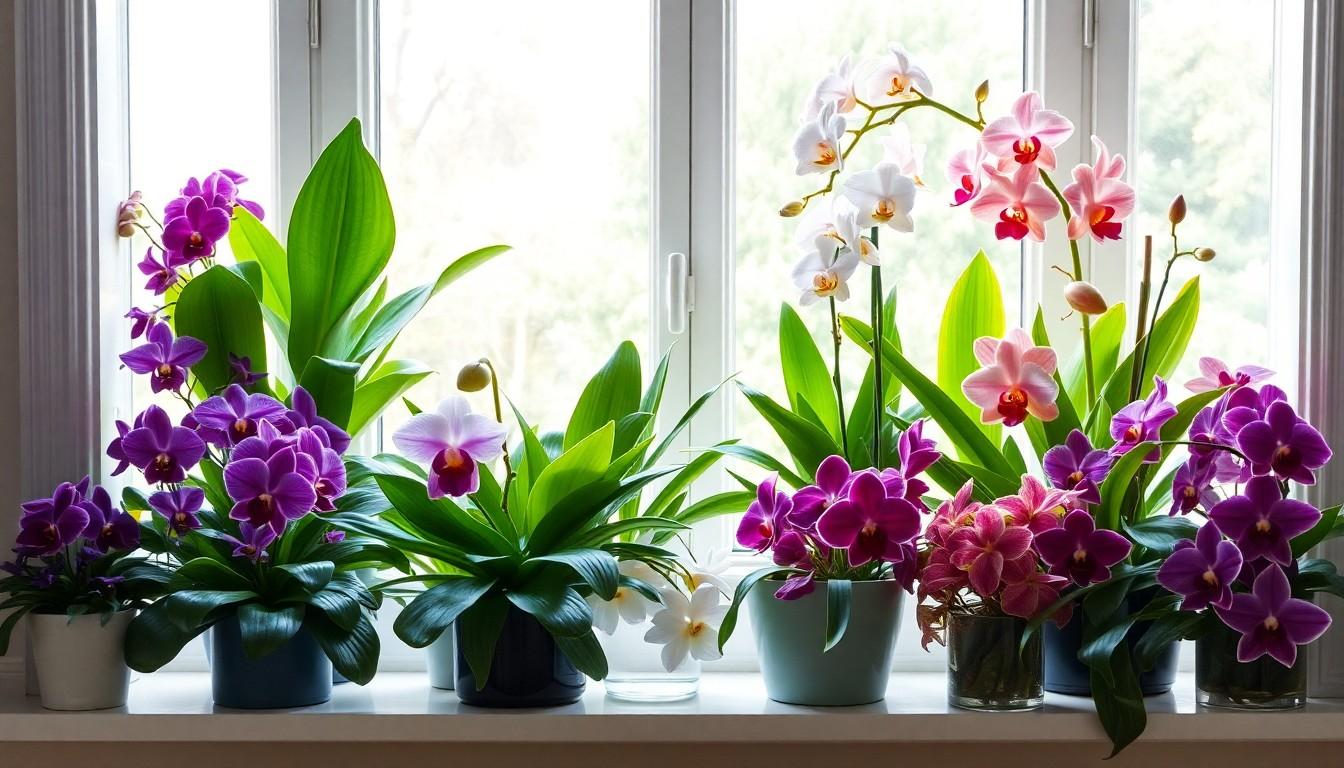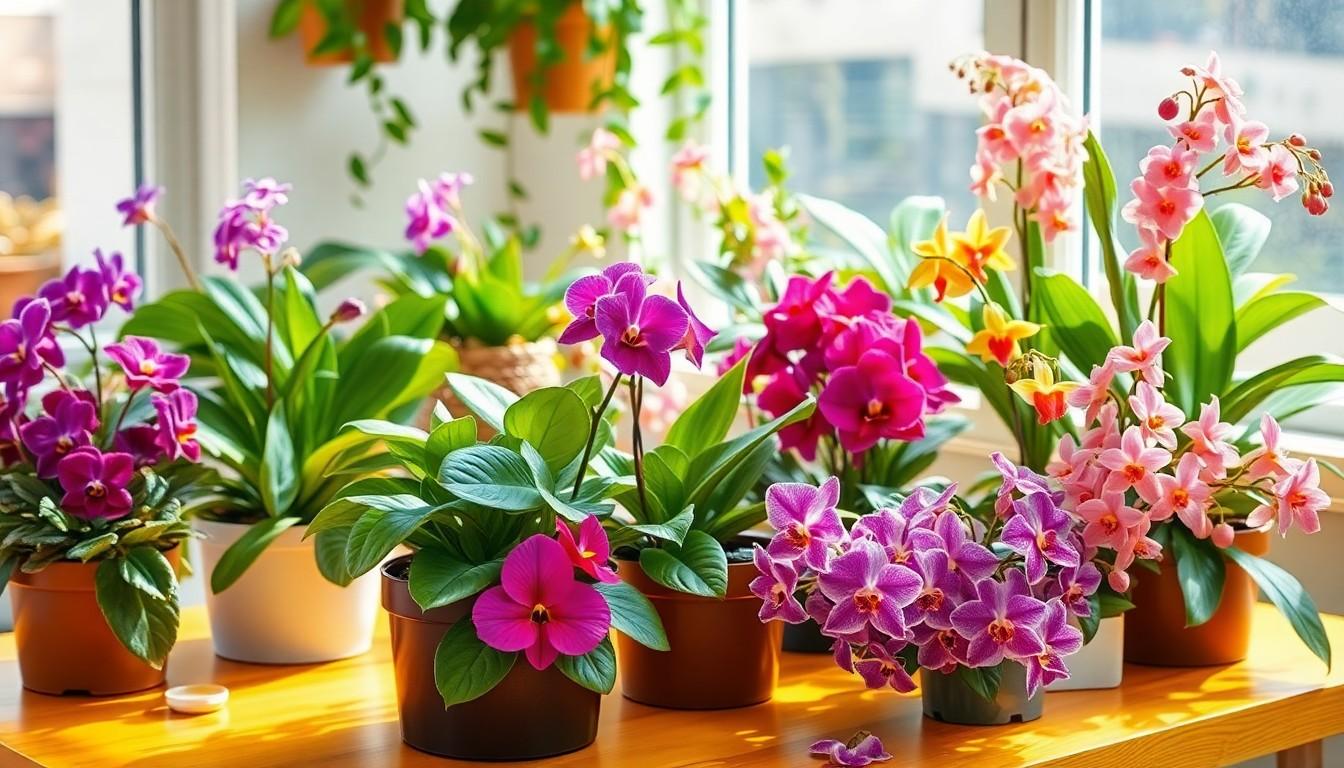If your home feels a bit too much like a beige box, it’s time to let some color in. Common flowering houseplants not only brighten up a room but also bring a splash of personality that even your pet goldfish will appreciate. Imagine walking into a space filled with vibrant blooms, where every corner whispers, “Welcome to my floral paradise!”
Overview Of Common Flowering House Plants
Flowering houseplants enhance indoor spaces with vibrant colors. Numerous options exist, each bringing unique characteristics and care requirements. African violets bloom throughout the year, showcasing delicate purple to pink petals, thriving in indirect sunlight. Begonias offer colorful, textured leaves along with beautiful flowers, preferring high humidity and moderate light.
Geraniums add cheer with their bright blooms and fragrant leaves. Easy to care for, they flourish in sunny spots. Orchids, known for their exotic appearances, require specific humidity and watering conditions but reward owners with stunning and ornate flowers.
Kalanchoe stands out with its clusters of small, bright blooms. It thrives on low water and bright light. Another popular choice, pothos, produces rare flowers when grown under ideal conditions, mainly known for its lush green leaves instead.
Peace lilies feature elegant white blossoms, thriving in lower light and requiring moderate water. They add an air of sophistication, purifying the air while blooming intermittently throughout the year.
Conversing with potential houseplant owners involves understanding their preferences. Each plant offers unique traits, making plant selection a personal journey. Understanding specific care needs helps individuals choose plants that fit their lifestyles. With suitable arrangements and care, these flowering houseplants contribute to a colorful and lively atmosphere, enhancing the overall decor of any indoor space.
Popular Varieties

Numerous flowering houseplants enhance indoor spaces with vibrant colors and unique characteristics. Each variety offers distinct features that complement various decor styles.
African Violets
African violets thrive indoors, displaying delicate purple to pink blooms year-round. These plants prefer indirect sunlight and benefit from maintaining consistent moisture in their soil. Fertilizing every couple of weeks promotes healthy growth. Their compact size makes them ideal for tabletops, windowsills, or shelves, adding charm with minimal effort. Caring for African violets typically requires monitoring humidity levels since they flourish in moderately humid conditions.
Peace Lilies
Peace lilies are well-regarded for their elegant white blooms and air-purifying qualities. They adapt well to low light, making them perfect for dimly lit rooms or office spaces. Watering only when the soil feels dry ensures optimal growth. Their lush green foliage contrasts beautifully with the white flowers, creating an eye-catching display. Additionally, peace lilies thrive in humidity, so occasional misting can enhance their health.
Orchids
Orchids captivate with their exotic appearance and diverse flower colors. Known for requiring specific care, these plants need bright, indirect light and high humidity to flourish. A well-draining potting mix is essential to prevent root rot. Monthly fertilization during the growing season supports blooming. While they may seem challenging, successful orchid cultivation yields stunning flowers that add sophistication to any setting.
Care Requirements
Caring for flowering houseplants requires attention to light, water, soil, and fertilization. Each plant has specific needs to thrive and produce vibrant blooms.
Light Conditions
Bright, indirect light suits most flowering houseplants, promoting healthy growth. African violets thrive best in filtered sunlight, avoiding direct exposure that can scorch their leaves. Begonias also prefer bright, indirect light but can tolerate some direct sun during early morning hours. Geraniums flourish in full sun, so placing them in a south-facing window ensures abundant blooms. Orchids prefer bright but indirect light to produce striking flowers consistently. Kalanchoe enjoys plenty of light and will bloom more prolifically with adequate exposure. Peace lilies tolerate low light, making them ideal for shaded areas.
Watering Needs
Watering requirements vary among flowering houseplants. Consistent moisture is crucial for African violets, ensuring the soil remains slightly damp but not soggy. Begonias need careful watering; allowing the soil to dry out slightly between waterings promotes healthy growth. Geraniums prefer to dry out a bit between waterings, and overwatering can lead to root rot. Orchids typically require watering every 1 to 2 weeks, ensuring their roots are well-drained. Kalanchoe thrives on less water, needing only watering once the soil is dry. Peace lilies like their soil to be kept moist but can wilt if underwatered.
Soil and Fertilization
Potting soil plays a vital role in the health of flowering houseplants. A well-draining, lightweight mix suits African violets and begonias, providing the right balance of moisture retention and drainage. Geraniums prefer sandy, well-draining soil to prevent waterlogged roots. Orchids benefit from a specialized orchid mix that allows for excellent drainage and airflow around their roots. Kalanchoe thrives in a cactus soil blend to ensure proper drainage. Fertilizing every 4 to 6 weeks during the growing season promotes vibrant blooms for all flowering houseplants, using a balanced liquid fertilizer diluted to half strength.
Common Issues
Flowering houseplants can encounter various issues that affect their health and vibrancy. Being aware of these challenges simplifies care and promotes successful growth.
Pests and Diseases
Common pests such as aphids, spider mites, and mealybugs affect flowering houseplants. Aphids can sap plant juices, leading to stunted growth. Spider mites thrive in dry conditions and may cause yellowing leaves. Mealybugs, identified by their white cotton-like appearance, also weaken plants. Fungal infections like powdery mildew develop in overly humid environments. Regular inspection and proper care significantly reduce the risk of pest and disease infestations. Utilizing insecticidal soap or neem oil helps manage these issues organically.
Environmental Stress
Environmental stressors impact flowering houseplants’ health. Insufficient light leads to leggy growth or decreased blooming. Over or under-watering can cause root rot or wilting leaves. Temperature fluctuations, such as cold drafts or excessive heat, contribute to stress as well. Maintaining consistent conditions like humidity levels is crucial for plants like orchids and peace lilies. Monitoring these environmental factors ensures healthy growth and vibrant blooms. Opting for dedicated plant locations away from drafts also supports optimal health.
Conclusion
Incorporating flowering houseplants into home decor not only enhances the aesthetic appeal but also creates a lively atmosphere. Each plant offers unique beauty and care requirements, making the selection process a rewarding experience. By understanding individual preferences and providing the right conditions, anyone can enjoy the vibrant blooms that these plants bring to their living spaces.
With proper attention and care, flowering houseplants can flourish and transform any room into a floral paradise. Embracing this green journey adds personality and warmth to a home while fostering a connection with nature.

